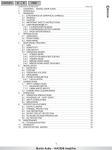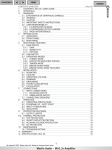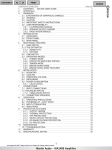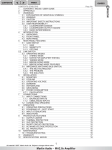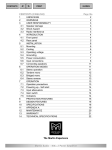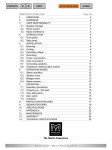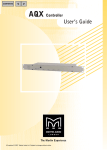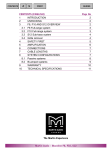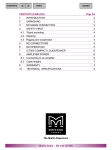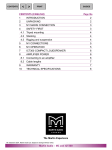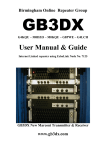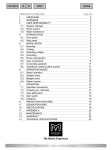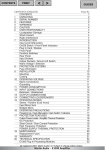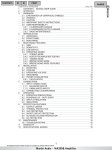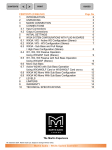Download Martin Audio MA2.8 Specifications
Transcript
< CONTENTS > APPLICATIONS GUIDE PRINT CONTENTS (ENGLISH) 1 2 3 3.1 3.2 3.3 4 4.1 4.2 5 5.1 5.2 5.3 5.4 5.5 5.6 5.7 5.8 6 6.1 6.2 6.3 6.4 7 7.1 7.2 7.3 7.4 7.5 8 9 10 11 12 13 14 GUIDES Page No UNPACKING WARNINGS USER RESPONSIBILITY Speaker damage Shock hazard Radio interference INTRODUCTION Front panel Rear panel INSTALLATION Mounting Cooling Operating voltage Grounding Power consumption Input connections Connecting speakers Impedance matching (MLS switch) OPERATION MODES Stereo operation Tandem mono Bridged mono Stereo reverse OPERATION Operation precautions Powering up - Soft start Input attenuators Gain switch Indicators PROTECTION FEATURES DESIGN FEATURES SPECIFICATIONS APPENDIX A MAINTENANCE WARRANTY TECHNICAL SPECIFICATIONS MARTIN AUDIO L O N D O N The Martin Experience Martin Audio – MA2.8 Power Amplifier 2 2 3 3 3 3 4 4 5 6 6 6 6 7 7 8 11 13 13 13 13 14 14 15 15 15 16 16 16 17 19 21 22 23 24 25 > APPLICATIONS GUIDE PRINT GUIDES This equipment conforms to the requirements of the EMC Directive 89/336/EEC, amended by 92/31/EEC and 93/68/EEC and the requirements of the Low Voltage Directive 73/23/EEC, amended by 93/68/EEC. Standards Applied EMC Emission Immunity Electrical Safety 1 EN55103-1:1996 EN55103-2:1996 EN60065:1993 UNPACKING Each Martin Audio MA Series amplifier is built to the highest standard and thoroughly inspected before it leaves the factory. After unpacking the unit, examine it carefully for any signs of transit damage and inform your dealer if such damage is found. It is suggested that you retain the original packaging so that the unit can be repackaged at a future date if necessary. Please note that Martin Audio and its distributors cannot accept responsibility for damage to any returned product through the use of non-approved packaging. 2 WARNINGS • Do not use this amplifier if the mains cable is damaged. • Always operate the amplifier with the chassis ground wire connected to the electrical safety earth. • Do not parallel or series connect an amplifier output with any other amplifier output. Do not connect the amplifier output to any other voltage source, such as battery, mains source or power supply, regardless of whether the amplifier is turned on or off. • Do not run the output of any amplifier back into another channel's input. • Do not block the air intake or exhaust ports. • Do not operate the amplifier near any source of heat. • Do not spill water or other liquids into or on the unit. Do not operate the amplifier if liquid ingress is suspected. • Do not remove top or bottom covers. Removal of the covers will expose hazardous lethal voltages and may void warranty. There are no user serviceable parts inside the amplifier. Refer servicing to qualified personnel only. • Keep this manual for future reference. 2 Martin Audio – MA2.8 Power Amplifier ENGLISH < CONTENTS 3 > APPLICATIONS GUIDE PRINT GUIDES USER RESPONSIBILITY 3.1 Speaker damage Many loudspeakers can be easily damaged or destroyed by overpowering, especially with the high power available from a bridged amplifier. Always check the speakers continuous and peak power capabilities. Even if the gain is reduced by using the amplifier's front panel attenuator, it is still possible to reach full output power, if the input signal level is high enough. 3.2 Shock hazard Power amplifiers are capable of producing hazardous output voltages. To avoid electrical shock, do not touch any exposed speaker wiring when the amplifier is operational. See page 11 regarding correct connection of outputs to loudspeakers. 3.3 Radio interference A sample of this product has been tested and complies with the limits for the European Electro Magnetic Compatibility (EMC) directive. These limits are designed to provide reasonable protection against harmful interference from electrical equipment. This product uses radio frequency energy and if not used or installed in accordance with these operating instructions, may cause interference to other equipment. Compliance with the (EMC) directive does not automatically guarantee non-disturbance of susceptible equipment in close proximity to this amplifier. If the amplifier is suspected of causing interference, this can be easily checked by powering the unit on and off and observing the disturbance. The user can correct the interference by one or more of the following steps: 1. Increase the distance between the equipment. 2. Connect the power cable to a socket on a different circuit from that to which the affected unit is connected. 3. If a radio receiver is affected (normally only am receivers are affected); re-orientate the antenna. 4. Check if the affected equipment complies with the EMC limits for immunity, (CE-labelled). If not, address the problem with the manufacturer or supplier. All electrical products sold in the EC must be approved for immunity against electromagnetic fields, high voltage flashes and radio interference. 3 Martin Audio – MA2.8 Power Amplifier ENGLISH < CONTENTS 4 > APPLICATIONS GUIDE PRINT GUIDES INTRODUCTION Thank you for purchasing a MARTIN AUDIO power amplifier. This manual contains important information on operating your amplifier correctly and safely. Please take some time to read this manual and familiarize yourself with the advanced features of this amplifier. 4.1 The front panel ➄ ➀ ➂➃ ➁ ➁ Figure 1. Front panel ➄ ➅ 1. Carry/protection handle Both handles can be used to carry the amplifier; they also act as protection for the front panel and controls. In fixed installations or where rack front covers are too shallow, they may be removed by unscrewing the retaining bolts behind the front panel. 2. Input level attenuators These controls are used to set the signal level entering the amplifier. They are calibrated in dB to assist the set up of active loudspeaker systems. (See page 16). 3. Protect indicator LED This indicator illuminates if the amplifier attempts to function above its maximum operating temperature (90ºC). The indicator first comes on as a warning to either turn down the input level or check the cooling arrangements, after which point the amplifier will mute the input signal. When the cooling fans have returned the output heat sinks to the normal operating temperature, the input signal is un-muted. The Protect LED also illuminates when constant signals above 12kHz at full power are detected at the output terminals. When this occurs the input signal is muted until the VHF signal is no longer present. (See page 17). 4. Clip/limit indicator LED This indicator signals when the amplifier output is clipping or limiting. It has two different indication states: • When the clip limiter is engaged, it has a short time constant and illuminates briefly. (See pages 16-17). • When the clip limiter is not engaged, it has an increased time constant and illuminates for a longer period. 4 Martin Audio – MA2.8 Power Amplifier ENGLISH < CONTENTS < > APPLICATIONS GUIDE PRINT ENGLISH CONTENTS GUIDES 5. Fan grille filter A foam filter is located behind the front panel grille to prevent dust entering the amplifier. 6. Power switch This is used to power up the amplifier. (See page 7 and 15) 4.2 The rear panel ➃ ➃ ➁ ➀ ➀ ➁ Figure 2. Rear panel ➂ ➄ ➈ ➂ ➅ ➆ 1. Speakon connector This type of speaker connector may be unfamiliar to some users. A full description is found in the operation section. (See page 11). 2. Minimum load selector (MLS™) switch This switch is used to select the minimum nominal speaker impedance the amplifier is going to drive (see page 12). 3. Clip limiter switch Turns the clip limiter on and off. (See page 17). 4. Input jack Alternative to using input XLR or for linking inputs with other amplifiers. (See page 9). 5. Input signal XLR (See page 8). 6. Polarity reverse switch for channel B For reversing the input signal polarity of channel B to allow bridged operation. (See page 13). 7. Input link switch Allows a single input to drive both channels simultaneously. (See page 13). 8. Gain select switch Allows amplifier gain to be switched between 32dB (1.55Vrms input sensitivity) and 38dB gain (0.775mV input sensitivity). (See page 16). 9. AC power cable (See page 6). 5 Martin Audio – MA2.8 Power Amplifier ➇ 5 > APPLICATIONS GUIDE PRINT GUIDES INSTALLATION 5.1 Mounting The amplifier is two rack units high (2U) and will mount in a standard EIA 19'' rack. Amplifiers may be stacked directly on top of each other. There is no need for spacing between units. If it is the intention to fill a rack with amplifiers, we recommend racking is started from the bottom of the rack. It is also recommended that rear supports are used for amplifiers mounted in the middle of the rack, especially if used as part of a portable system. 5.2 Cooling Your amplifier uses forced air cooling to maintain a low and even operating temperature. All MARTIN AUDIO MA Series amplifiers have front to rear cooling. Never try to reverse the air flow, as the amplifier needs a pressure chamber between the fans and heat sink and this only operates in one direction of the air flow (see Design features on page 19). Should the heat sink get too hot, its sensing circuit will mute the hot channel. If the power supply overheats, another sensing circuit will mute all output channels until it cools down to a safe operating temperature. Make sure that there is an adequate air supply in front of the amplifier and that the rear of the amplifier has sufficient space to allow the exhaust to escape. If the amplifier is rack mounted, do not use covers or doors on the front or rear of the rack. For fixed installations with a central cooling system, usually found in fixed installations with a dedicated rack room, it may be necessary to calculate the maximum heat emission. Refer to Power consumption on page 8. 5.3 Operating voltage WARNING! A label below the mains cable on the rear of the amplifier indicates the selected AC mains operating voltage. Connect the power cable only to the AC source referred to on the label. The warranty will not cover damage caused by connecting to the wrong type of AC mains. For converting a 230 volt amplifier to 115 volt or vice-versa, see Appendix A. MARTIN AUDIO switch mode amplifiers use primary switching, i.e. the mains is rectified directly before the transformer, which means that the power supply is insensitive to the mains frequency and will operate from DC to 400Hz. The amplifier is supplied with an approved European AC line connector. If this connector is not appropriate for your country, it can be cut off and wired to a suitable connector in the following way: 6 Martin Audio – MA2.8 Power Amplifier ENGLISH < CONTENTS < > APPLICATIONS GUIDE PRINT BROWN BLUE GREEN/YELLOW - GUIDES LIVE NEUTRAL EARTH Once connected to a suitable AC supply, the amplifier can be started with the power switch. When you power up the amplifier it takes a couple of seconds to self check (this is known as the "soft start" or "slow start" sequence). The fans then blow at high speed before going into "idle". The 2 bottom green LED's then illuminate to show the amplifier is operational. 5.4 Grounding There is no ground lift switch or terminal on this amplifier. The signal ground is always floating via a resistor to chassis and the grounding system is automatic. If a potential above 0.6V presents itself between signal ground and chassis ground, a short circuit is introduced between the two, thereby enabling electrical protection. If a unit in the system is faulty, its mains fuse will blow, due to this automatic ground system. If however, you wish to tie the signal ground to chassis, connect the XLRconnector's shell lug to pin 1. In the interest of safety never disconnect the earth pin on the mains connector. For compliance with the EMC directive (conducted emissions), there is an AC mains filter. This filter needs the chassis ground for reference, otherwise a current loop is formed via the signal ground. Use the balanced input to avoid hum and interference. 5.5 Power consumption There are three ways to define the power/current consumption of the amplifier: First, the peak current draw at full power output. Under this condition the amplifier will operate for less than 2 minutes before thermally limiting. Secondly, the maximum expected average current under worst case program material, which corresponds to 1/3 of full power according to the FTC-standard. At this level the music will be in a state of constant clip and is therefore the highest power level one can obtain without completely obliterating the program. Lastly, the "normal operating power", as defined by EN60065 as a measurement level for approval and testing to this standard. The normal operating power is measured using pink noise, with an average output power equal to 1/8 of full power. The one-eighth power is the maximum volume music can be re-played without continuous amplifier clipping. It also corresponds to headroom of 9dB, which is very low for normal program material. If operating the amplifier into a sustained 2 ohm load, protection circuits within the amplifier will limit the long-term current draw, and thermal protection may occur. 7 Martin Audio – MA2.8 Power Amplifier ENGLISH CONTENTS < > APPLICATIONS GUIDE PRINT MAX OUTPUT POWER MAINS INPUT POWER Power MA2.8 GUIDES Full Power 1/3 Power 1/8 Power sine wave note 1 note 2 Idle 8 ohms 2X 1100 3100 1300 700 130 4 ohms 2X 1400 4300 1700 900 130 2 ohms 2X 1400 4700 1700 900 130 note 1 Average power with music as program note 2 source. The amplifier driven to clip level. Normal music power with 9dB headroom, IEC standard power rating. Table 1. The current draw can be calculated by dividing the mains input power by the mains voltage. We recommend that you design the power distribution for at least the current at 1/8 power or 1/3 power for heavy duty demand like discos etc. The heat power can be calculated as the following example: If we consider a headroom of at least 9dB and a 4 ohm load on an amplifier producing 1400 watts per channel. The 1/8 power per channel is then; 1400 ÷ 8 = 175 watts, total output; 2 x 175 = 350 watts. The power consumption according to the chart above is then 900 watts. The heat power produced is the difference between the power consumption and power output; 900 - 350 = 550 watts per amplifier. 5.6 Input connections Both inputs are balanced on 3 pin XLR type connectors and wired pin 2 hot, pin 3 cold, pin 1 ground/shield: PIN 1 PIN 2 PIN 3 - + – SIG. GROUND/SHIELD HOT (+) COLD (-) 2 1 3 SIG. GND. Figure 3. XLR input connector pin-out 8 Martin Audio – MA2.8 Power Amplifier ENGLISH CONTENTS < > APPLICATIONS GUIDE PRINT GUIDES There are also TRS jacks for linking etc. They are wired as follows: TIP RING SLEEVE - HOT (+) COLD (-) SHIELD/SIG. GROUND SIG.GND – + Figure 4. TRS phone plug The input impedance is sufficiently high (20kohms balanced) to allow "daisy-chaining", or multiple parallel input connections. To daisy-chain, use the TRS jacks provided on each channel. The input circuits also have high enough headroom to accept the maximum output level from virtually any low-level signal source. INPUT Normal Pol.B Reverse Pol.B Stereo Link A+B Gain 38 dB Gain 32 dB CH.B CH.A Mono Bridge XLR 1/4" Pin 1 Gnd Sleeve 2 Pos Tip 3 Neg Ring Must be grounded 230V AC 40-440Hz Figure 5. Rear panel connectors 9 Martin Audio – MA2.8 Power Amplifier ENGLISH CONTENTS < > APPLICATIONS GUIDE PRINT GUIDES Do not use XLR and TRS jacks on the same channel simultaneously for mixing or other purposes. Balanced Output Signal Grounded Shield 1 Amplifier Input 2 2 3 Amplifier Input Balanced Output Chassis Grounded Shield 1 1 3 2 2 3 1 3 Figure 6. Balanced line To use an unbalanced source, connect pin 3 (ring on TRS jack) to the shield of the connector. If you leave one pin disconnected, you will lose 6dB in gain. Amplifier Input Unbalanced Output 1 2 2 3 1 3 Amplifier Input Unbalanced Output + 2 1 3 + – – Figure 7. Unbalanced line connection A better method for using unbalanced sources is shown in Figure 8. This is similar to the connection for balanced lines, but pin 3 is connected to the shield at the source. The hum and noise rejection for the cable is equivalent to that for a balanced line. To minimize hum in the audio, use balanced inputs whenever possible. Unbalanced Output Signal Grounded Shield 1 Amplifier Input 2 2 3 1 3 Amplifier Input Unbalanced Output + 2 1 3 + – – Figure 8. Balanced line with unbalanced equipment 10 Martin Audio – MA2.8 Power Amplifier ENGLISH CONTENTS < > APPLICATIONS GUIDE PRINT GUIDES 5.7 Connecting speakers Speaker connections are made via the two Neutrik NL4FC Speakon connectors (1). These connectors meet the EC safety requirements. They are wired as follows: Pin Pin Pin Pin -1 +1 -2 +2 Speaker ground. Speaker positive. No connection. No connection. 21+ 2+ 1- Figure 9. Speakon connector Please note that this is the standard wiring convention for Speakon connectors adopted worldwide. Never connect either output terminal to ground or to some other output or input terminal (see warning on page 2). For normal twochannel operation, connect each speaker load across the outputs positive and ground terminals. Pay attention to speaker polarity; loudspeakers connected out of polarity can degrade sound quality. Keep the speaker cables as short as possible and use a good quality stranded speaker cable. Do not use shielded wire, such as microphone or guitar cable. Remember that the speaker cable robs the power of the amplifiers in two ways: It increases the load impedance and introduces resistive power losses. 5.8 Impedance matching (MLS switch) The MLS™ switches (2) are located on the rear panel. The MLS (Minimum load select) switches offer impedance matching, so you can drive the MA2.8 into 2 ohms without increased heat loss. As stated earlier the MA2.8 can produce at least 1100 watts into any impedance between 1.5 and 8 ohms. Utilise higher MLS™ positions when connecting to lower impedances as shown in Table 2. 11 Martin Audio – MA2.8 Power Amplifier ENGLISH CONTENTS < > APPLICATIONS GUIDE PRINT MA2.8 GUIDES MLS Switch Position LOAD CONFIGURATION -5dB 16 ohms Stereo (2 channel) 160W 8 ohms 4 ohms Stereo (2 channel) Stereo (2 channel) 300W 570W -4dB -2dB 0dB 180W 340W 520W 650W 1100W 1100W 1400W 350W 680W 1900W[2] 2 ohms Stereo (2 channel) 1040W 1200W 1200W 1400W[1] 1400W[2] 2900W[2] 16 ohms Bridged mono 600W 700W 1300W 2000W 8 ohms Bridged mono 1200W 1400W 2200W 2800W 4 ohms Bridged mono 2100W 2400W 2400W 2800W Table 2. [1] Component tolerance dependent. [2] Continuous power, one channel driven or peak power both channels driven. (Thermal protection may occur at high continuous power). Power in watts (EIA 1kHz,1% THD). Channel Impedance MLS Power Comments A 8 -2dB 650W Power B 8 -2dB 650W reduction A 4 0dB 1900W High peak B 4 0dB 1900W power A 8 0dB 1100W Power B 2 -4dB 1200W matching A 8 -2dB 650W Power B 4 0dB 1900W sharing Table 3. MLS™ positions can be different for each channel and a variety of combinations can be achieved see Table 3. The way to find the best MLS™ position for your application is by experimentation using table 3 for initial starting positions. The amplifier is very well protected (even down to 0.3 ohms). The MA2.8 amplifier is a power converter and when you select MLS™ positions you are allocating a portion of power from 3000 watts. 12 Martin Audio – MA2.8 Power Amplifier ENGLISH CONTENTS > APPLICATIONS GUIDE PRINT GUIDES dB MLS Switch OUTPUT CH.B 0 1+ CH.B+ 1– CH.B– -2 -4 -5 Figure 10. MLS switches on rear panel 6 OPERATION MODES 6.1 Stereo operation For stereo (dual channel) operation, leave the Link and Phase reverse switches in the un-depressed position. In this mode, both channels operate independently of each other, with their level attenuators controlling their respective levels. Never connect either output terminal to ground or in parallel. The recommended minimum nominal impedance for stereo or tandem operation, is 2 ohms per channel. 6.2 Tandem mono For tandem (dual channel-single input) operation, depress the Link switch. Both channels can now be driven by a signal at either input connector. The output connection is the same as in stereo mode. You can use either TRS connectors for linking out etc. Do not use the remaining XLR and TRS connectors for mixing or other purposes. Both level attenuators are active, allowing you to set different levels for each channel. Never connect either output terminal to ground or in parallel. 13 Martin Audio – MA2.8 Power Amplifier ENGLISH < CONTENTS < > APPLICATIONS GUIDE PRINT GUIDES 6.3 Bridged mono To bridge the amplifier, depress the Link switch (7) and Phase reverse switch (6). Both channels are then driven by a single signal at either input. You can use any remaining input connectors for linking etc. Do not use the remaining XLR and TRS as input jacks simultaneously for mixing or other purposes. To obtain an output, connect the speaker leads to pin +1 on channel A Speakon to speaker positive terminal and pin +1 on channel B Speakon to speaker negative terminal. Do not connect either of the -1 (negative) pins of the Speakons. Do not connect speakers to channel A or B in the normal manner in bridge mode, as this can cause serious damage. The recommended minimum nominal impedance for bridged mono is 4 ohms (equivalent to driving both channels at 2 ohms). Driving bridged loads of less than 4 ohms may cause a thermal overload. 2 + 1 3 + – CH A + – – I/P LINK + – 2 1 3 PHASE INVERT + + – CH B + – – Figure 11. Bridge mono connection Both level attenuators must be at the same position. We recommend that you put them in the 0dB (full) position. 6.4 Stereo reverse This mode is similar to the Tandem mono mode. Apart from depressing the Link switch, you also depress the Phase reverse switch, as in the Bridge mono. Channel B is now phase reversed. To compensate for that, connect pin +1 on channel B Speakon to speaker negative terminal and pin -1 on channel B to speaker positive terminal. 14 Martin Audio – MA2.8 Power Amplifier ENGLISH CONTENTS > 2 APPLICATIONS GUIDE PRINT + 1 3 + – CH A + – 1 PHASE INVERT 3 + – I/P LINK 2 GUIDES + + – CH B + – – + Figure 12. Stereo reverse mode Channel A output is connected as in the normal stereo mode. By having channel A and B operating in opposite polarity, the energy storage in the power supply is more efficient. This means that the amplifier can deliver up to 10% more power than in tandem mono mode. This is significant for signals below 100Hz (sub bass etc.). 7 OPERATION 7.1 Operation precautions • Make sure that the power switch is off before making any input or output connections or operating the switches on rear panel. See pages 6-11 about installation. • Make sure that the AC mains is correct and the same as that printed on the rear panel of the amplifier. See pages 6-8 about operating voltage and power consumption. • Make sure that the switches on the rear panel for operation modes, clip limiters and the MLS™ switches are in the correct position. See pages 13 and 14 about operation modes, page 16, about clip limiters and page 12 for the MLS switches. • It is always a good idea to turn down the gain controls during power up as this prevents speaker damage, especially if there is a high level signal at the input. 7.2 Powering up - Soft start When you power up the amplifier it takes a couple of seconds to self check. This is known as the "soft start" or "slow start" sequence. The fans then blow at high speed before going into "idle" and the two bottom green LED's illuminate to show the amplifier is operational. 15 Martin Audio – MA2.8 Power Amplifier ENGLISH < CONTENTS < > APPLICATIONS GUIDE PRINT GUIDES 7.3 Input attenuators The two input level attenuators on the front panel adjust the signal level for their respective amplifier channel in all modes. They are calibrated in dB to assist setting up active loudspeaker systems. In bridged mode, both controls must be in the same position, so that the speaker load will be shared equally between the channels. 7.4 Gain switch The gain switch located on the rear panel is for changing the input sensitivity of the amplifier. Most professional mixing consoles operate at a nominal level of +4dBu. Therefore, use the 32dB position (depressed switch), to give you plenty of fader movement. On the other hand, for a disco mixer that operates at a nominal level of 0dBu, use the upper position setting, which has a sensitivity of 0dBu (0.775Vrms) for full power in 4 ohms. 7.5 Indicators Figure 13. Front panel indicators The two bottom green "ON" LED's indicate when the power supply and output stage is operating correctly. The "-40 dB" LED's illuminate when the output signal is greater than -40dB. 0dB is referenced to full output power. These LED's also act as signal present indicators. The ''Clip/limit'' LED indicates when the amplifier output is clipping or limiting. It has two different indication states: * When the clip limiter is engaged it has a short time constant and illuminates briefly. * When the clip limiter is not engaged it has an increased time constant and illuminates for a longer period. The remaining yellow "Protect" LED's indicate if the temperature or VHF protection circuits are activated. These are described on page 17. 16 Martin Audio – MA2.8 Power Amplifier ENGLISH CONTENTS 8 > APPLICATIONS GUIDE PRINT GUIDES PROTECTION FEATURES Each MARTIN AUDIO MA Series amplifier has many advanced protection features that will protect both the amplifier and the speakers connected to it, should a fault condition arise. Under normal use these features are inaudible. All protection circuits are independent. Output limiter An output limiter is included to avoid amplifier clipping. When an amplifier is severely overdriven, its output waveform is clipped (its peaks are squared off) - reducing the crest factor. In extreme cases, the waveform can approach that of a square wave. An amplifier is normally capable of producing far more power under these conditions than its normal undistorted rated power output. The limiter works by monitoring the output and comparing the distortion produced between the input and output of the amplifier. If the distortion exceeds 1%THD for any reason (voltage or current clipping), the limiter reduces the input signal proportionally. Note that, if the signal is distorted or clipped before it reaches the amplifier, the clip limiter will not be activated. Under normal operation the clip limiting is inaudible. The limiter can be turned On or Off by depressing the relevant clip limit switch (2). Some manufacturers of loudspeaker processors do not recommend the use of clip limiters in amplifiers, as they tend to upset the tracking of the processor's limiters. Apart from this one exception, MARTIN AUDIO recommend leaving the clip limiters switched "on" (button depressed). As a by-product, when the amplifier comes out of a protect condition, the output level has a slow rise time - the effect is like turning the gain up slowly. Thermal protection When the amplifier is driven very hard into a low impedance load, the cooling fans will run at high speed. If these operating conditions continue, the Protect indicator(s) will illuminate indicating that the amplifier is about to go into thermal shutdown. After five seconds the amplifier will go into thermal protect, by muting the input signal. After 15-20 seconds the amplifier will have cooled down enough for the amplifier to come out of shutdown and operate as normal. If the load conditions remain unchanged the thermal protection will be reinitiated. Thermal protection starts when the heatsink reaches a temperature above 90ºC. VHF protection If a signal of more than 12kHz, at full power, is detected at the amplifier outputs and lasts for more than five seconds, the VHF protection mutes the 17 Martin Audio – MA2.8 Power Amplifier ENGLISH < CONTENTS < > APPLICATIONS GUIDE PRINT GUIDES input signal. (This is indicated on the front panel (3) labelled “Protect”). After five seconds the outputs will un-mute and return to normal operation, unless the output signal has remained unchanged in which case the VHF protection will re-initiate. This circuit is inaudible in normal use, however it can be turned off. If the VHF protection is required to be turned off i.e. for studio monitors, please consult your supplier, as this is a non-user adjustment. Short circuit protection All MARTIN AUDIO MA Series amplifiers are completely short circuit protected. The protection circuit permits very high peak currents, but still holds the output devices within their safe operating area. If a short circuit is maintained, the channel affected will eventually go into a thermal protect cycle until the short circuit is removed. AC mains voltage protection If the AC mains voltage is outside the operational window (over or under voltage), the power supply will automatically shut down. When the mains voltage is above the minimum start voltage and below its maximum operating voltage the amplifier will restart. It takes a couple of seconds to self check (this is known as the "soft start" or "slow start" sequence), the gain will gradually be increased back to the previous set level and the fans will blow at high speed before going into "idle". The two green "ON" LED's then indicate that the power supply and output stage is operating correctly. D.C. protection There are two types of DC protection: • Fuses on the supply branches of each channel. • A DC crowbar protection circuit that shorts the output if more than 10 volts is detected on the outputs. Both these circuits come into effect once a DC level is detected. 18 Martin Audio – MA2.8 Power Amplifier ENGLISH CONTENTS 9 > APPLICATIONS GUIDE PRINT GUIDES DESIGN FEATURES Cooling MARTIN AUDIO MA Series amplifiers run very cool due to a patented heat exchanger. The bi-polar output devices are mounted directly onto a copper heat sink thereby avoiding thermal losses normally found when using mica washers. The heat sink is mounted horizontally in front of a pressure chamber and the air flow is constant along the whole heat sink. When cool air hits the geometric fins of the heatsink, turbulence is produced thereby enabling efficient cooling. (In a conventional tunnel design the end of the heat sink away from the fan invariably gets hotter than that directly in front of the fan). Light weight The MA 2.8 switch mode amplifier has a very good power to weight ratio, (280w/Kg) making it one of the most powerful, lightweight 2u amplifiers available. This is achieved not only by the design of the power supply and heatsink but also by the use of an alloy chassis making rear rack supports unnecessary in most applications. Switch mode power supply (SMPS) Switch mode power supplies are the modern solution to the problems of size and weight. However, early examples of SMPS used in power amplification were not ground breaking and literally adopted the type of supply found in many computers today. The MARTIN AUDIO SMPS is different in that it is regulated. Whilst the SMPS may sound complex it is actually very straightforward with high reliability. The net result is good bass and fast response. Because the supply is regulated, the power amplifier will produce the same power output even if the AC line voltage falls by more than 20%! Efficiency is also assured, and in the case of the MA2.8 this is especially apparent; its power supply draws only 4kW and yet it produces 2 x 1400W. (See figure 14). 19 Martin Audio – MA2.8 Power Amplifier ENGLISH < CONTENTS < > APPLICATIONS GUIDE PRINT GUIDES 90 80 70 Voltage [V] 60 50 2 40 30 20 1 10 3 0 0 5 10 15 20 25 30 35 40 45 50 Current [A] Figure 14. Current-voltage characteristic of different power supply topologies. 1) Conventional power supply shows voltage drop due to internal resistance. 2) Regulated power supply used by MARTIN AUDIO. 3) Unregulated switch mode power supply with current limiting. Traditional PSU's can behave erratically at low frequencies, particularly under clip conditions with the rise in their output impedance producing uncontrollable speaker cone movement. MARTIN AUDIO SMPS produces its rated power output at all frequencies regardless of speaker demands and AC line conditions. Minimum Load Switch (MLS™) Thanks to the regulated SMPS, the maximum power available for the output stages can be adjusted without increased heat dissipation or efficiency loss. This allows users to match the output power with the loudspeaker impedance. Because the amount of power delivered into a load is dictated by its impedance (at 2 ohms you use the least voltage but use the most current), the MLS switches can be used to advantage to enable powers in excess of the normal power rating to be produced. 20 Martin Audio – MA2.8 Power Amplifier ENGLISH CONTENTS < 10 > APPLICATIONS GUIDE PRINT GUIDES SPECIFICATIONS Safety approvals MARTIN AUDIO MA Series amplifiers are designed to meet EN60065 electrical safety standards. EMC approvals EMC stands for Electro Magnetic Compatibility. This implies that the equipment should have low emission of radio frequencies, directly as electromagnetic fields in the air and as conducted from the cables from and to the unit. The unit should also be able to handle electromagnetic fields, high voltage flashes and radio interference, coming into the unit via the air or cables. Emission The regulations now cover the frequency range from 150kHz to 300MHz. The maximum level radiated from a unit has to be below 100µV, (0.0001V). Immunity The equipment should be able to handle three different types of interference: • Electrostatic discharges up to 8kV, hitting the chassis or cables. • Transients and bursts up to 1kV conducted through the cables to the unit. • Electromagnetic fields up to 3V/m, radiated on the unit and the cables in the frequency range of 27 - 500MHz. We have extended the tests in two cases and chosen a standard used for heavy industrial situations. First, we have tested conducted disturbances in the frequency range 150kHz - 80MHz, by injecting 3V amplitude modulated (80%) signals into all the cables (inputs, outputs and mains). This covers noise from AM transmitters, which are still in use in some areas. Secondly, we have extended the range for electromagnetic fields to 26 - 1000MHz, with a level of 6V/m and 80% AM modulated. In the range 895 - 905MHz, we test with field strength of 35V/m and 100% pulse modulation. This emulates the signals from a mobile phone close to the unit. In all cases the noise plus distortion is below 1%, at normal operation level, (normal operation level is 1/8 of full power or -9dB under clip point according to EN60065). 21 Martin Audio – MA2.8 Power Amplifier ENGLISH CONTENTS < 11 > APPLICATIONS GUIDE PRINT GUIDES APPENDIX A Mains voltage selection All Martin Audio MA Series amplifiers are normally shipped for 230 Volt AC operation only. For use on 115 Volts AC, internal modifications to the power supply board must be made. Warning: This modification should only be carried out by an experienced service technician. Please contact MARTIN AUDIO for information. 22 Martin Audio – MA2.8 Power Amplifier ENGLISH CONTENTS < 12 > APPLICATIONS GUIDE PRINT GUIDES MAINTENANCE Under normal use the amplifier should give years of trouble free service. The only user maintenance required from the user is to vacuum the front grille periodically. In some extreme cases it may be necessary for your supplier to clean the inside of the amplifier. These conditions usually occur after prolonged use in environments using "cracked-oil" smoke machines. If you are using your amplifier for heavy-duty use i.e. concert touring or industrial music, it is recommended that you have your amplifier serviced every 3 years, purely as a preventative measure. Troubleshooting These are typical things to check if you think your amplifier is faulty: Fault: No output. If the -40dB LED is functioning there is nothing wrong with the amplifier and the likely cause is an unsecured Speakon. Check that the VHF protection is not activated. If it is, remove possible high frequency oscillations from the relevant input. Fault: The amplifier goes into thermal protection when driven at low level. Check that your loudspeaker has not got a short circuit in its windings, (this can occur when the speaker coil gets warm). Fault: The amplifier goes into protect with power indicators off. Check that the AC line voltage is not outside the amplifier's operating range (130-260 volts). Over/under-voltage protection may have occurred. If the amplifier is connected by mistake to a 3-phase supply (415V), an internal non-resetable fuse or resistor may have blown and the amplifier must be returned to your supplier for service. Fault: The amplifier does not respond even after checking above items. In the unlikely event, that there is a non-user rectifiable fault, return the amplifier to your supplier or an approved service centre. Martin Audio Ltd cannot be held responsible for damage or injury, as a result of the top cover being removed. 23 Martin Audio – MA2.8 Power Amplifier ENGLISH CONTENTS < 13 > APPLICATIONS GUIDE PRINT GUIDES WARRANTY General The MA2.8 Powered Amplifier is warranted to be free from defects in components and factory workmanship under normal use and service, for a period of one year from the date of original purchase. During the warranty period, MARTIN AUDIO LTD or its nominated agents, will undertake to repair, or at its discretion, replace this product at no charge to its owner, when failing to perform as specified, provided the unit is returned undamaged, in its original packaging, shipping pre-paid, to the factory, distributor or authorised service facility. This warranty shall be null and void, if the product is subjected to: 1) Repair work or alteration by person other than those authorised by MARTIN AUDIO LTD or its agents. 2) Shipping accidents, act of God, war, civil insurrection, misuse, abuse, operation with incorrect AC voltage, operation with faulty associated equipment, exposure to inclement weather conditions and normal wear and tear. Units, on which the serial number has been removed or defaced, will not be eligible for warranty service. 3) MARTIN AUDIO LTD shall not be responsible for any incidental or consequential damages, with respect to the products warranted. MARTIN AUDIO LTD reserve the right to make changes or improvements in design or manufacturing, without assuming any obligation to change or improve products previously manufactured. This warranty is exclusive and no other warranty is expressed or implied. This warranty does not affect your statutory rights. International Please contact you supplier for this information, as rights and disclaimers may vary from county to country. 24 Martin Audio – MA2.8 Power Amplifier ENGLISH CONTENTS < 14 > APPLICATIONS GUIDE PRINT GUIDES TECHNICAL SPECIFICATIONS MA2.8 INPUT IMPEDANCE GAIN SELECT SWITCH CMRR@1kHz OUTPUT IMPEDANCE@1kHz POWER BANDWIDTH SLEW RATE HUM/NOISE CHANNEL SEPARATION MAINS OPERATING VOLTAGE PROTECTION 20kohms (balanced) 10kohms single ended 38dB (I/P sens 0.775V), 32dB (I/P sens 1.55V) >50dB 0.06 ohms 10Hz - 20kHz 20V/us <-105dB 1kHz - 90dB 10kHz - 80dB 120 - 270 (minimum start voltage 190) full output power maintained 180 - 280V. Optional (65 - 135V) operation. DC, High temperature, Turn on, VHF, Over and under voltage, Clip Limiters. Short circuit. DISTORTION THD 20Hz - 20kHz and 1W - 1000W THD at 1kHz and 1100W DIM 30 at 500W CCIF (13 and14 kHz) at 500W SMPTE (60Hz and 7kHz) at 500W 4 4 4 4 4 ohms ohms ohms ohms ohms 0.08% 0.03% 0.02% 0.03% 0.08% POWER MATRIX LOAD 16 ohms 8 ohms 4 ohms CONFIGURATION Stereo (2 channel) Stereo (2 channel) Stereo (2 channel) -5dB 160W 300W 570W MLS SWITCH SETTING -4dB -2dB 180W 340W 350W 650W 680W 1100W 2 ohms Stereo (2 channel) 1040W 1200W 1200W 1400W[2] 0dB 520W 1100W 1400W 1900W[2] 1400W[1] 2900W[2] Bridged mono Bridged mono Bridged mono 600W 1200W 2100W 700W 1400W 2400W 1300W 2200W 2400W 2000W 2800W 2800W 16 ohms 8 ohms 4 ohms [1] = Component tolerance dependent. [2] = Continuous power, one channel driven or peak power both channels driven. Thermal protection may occur at high continuous power. Power in watts (E1A 1kHz, 1% THD). DIMENSIONS (W) 483mm x (H) 88mm x (D) 347mm (W) 19ins x (H) 3.5ins x (D) 13.7ins 10Kg (22lbs) WEIGHT SHIPPING DIMENSIONS (W) 560mm x (H) 190mm x (D) 500mm (W) 22.4ins x (H) 7.6ins x (D) 20ins SHIPPING WEIGHT 12Kg (26.4lbs) 25 Martin Audio – MA2.8 Power Amplifier ENGLISH CONTENTS CONTENTS < > APPLICATIONS GUIDE PRINT MA2.8 GUIDES Power Amplifier Please Click here to return to main menu Please Click here to visit our website MARTIN AUDIO L O N D O N The Martin Experience Century Point, Halifax Road, Cressex Business Park, High Wycombe, Buckinghamshire HP12 3SL, England. Telephone: +44 (0)1494 535312 Facsimile: +44 (0)1494 438669 Web: www.martin-audio.com E-mail: [email protected] CONTENTS < > APPLICATIONS GUIDE PRINT MA2.8 GUIDES Power Amplifier User’s Guide ENGLISH MARTIN AUDIO L O N D O N The Martin Experience



























